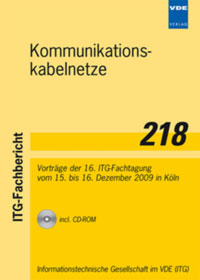Red VCSEL (655 nm) for POF applications
Conference: Kommunikationskabelnetze - 16. ITG-Fachtagung
12/15/2009 - 12/16/2009 at Köln, Germany
Proceedings: Kommunikationskabelnetze
Pages: 4Language: englishTyp: PDF
Personal VDE Members are entitled to a 10% discount on this title
Authors:
Wiesner, M.; Weidenfeld, S.; Eichfelder, M.; Roßbach, R.; Jetter, M.; Michler, P. (Universität Stuttgart, Institut für Halbleiteroptik und Funktionelle Grenzflächen, Allmandring 3, 70569 Stuttgart, Germany)
Abstract:
Vertical-cavity surface-emitting lasers (VCSEL) emitting in the red spectral range are a key device for data transmission via polymer optical fibers (POF). Many efforts have been made to overcome intrinsic laser material difficulties and thus improve the temperature stability of the VCSEL even at wavelengths near the POF attenuation minimum, resulting now in devices which show efficient continuous-wave lasing operation at 655 nm and at ambient temperatures of up to 50 °C. For high quality data communication laser emission in Gaussian fundamental mode (TEM00) is required, which is easily feasible by appropriate choice of internal VCSEL geometry parameters. Furthermore the emitted laser light is linearly polarized due to semiconductor material properties, hence no complex polarization control measures are needed. With these devices an error-free data transmission up to 2.1 Gbit/s via POF could be demonstrated. The reliability of VCSEL was estimated by lifetime tests to be > 10,000 hours.


